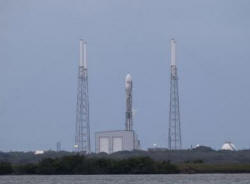|
 SpaceX
rocket launch, landing test, delayed by weather SpaceX
rocket launch, landing test, delayed by weather
 Send a link to a friend
Send a link to a friend
[April 14, 2015]
By Irene Klotz
CAPE CANAVERAL, Fla. (Reuters) - The
launch of an unmanned SpaceX rocket - and an innovative attempt to land
it on an ocean barge - were postponed on Monday due to poor weather at
the Florida launch site, officials said.
|
|
 The rocket, carrying a Dragon cargo ship bound for the
International Space Station, had been slated to blast off Monday
afternoon from Cape Canaveral Air Force Station, located just south
of NASA’s Kennedy Space Center. The rocket, carrying a Dragon cargo ship bound for the
International Space Station, had been slated to blast off Monday
afternoon from Cape Canaveral Air Force Station, located just south
of NASA’s Kennedy Space Center.
Thick clouds and nearby rain showers scuttled the launch less than
three minutes before liftoff. The flight was rescheduled for 4:10
p.m. on Tuesday.
Once the rocket dispatches its upper-stage and Dragon capsule, it is
programmed to flip around, fire engines to steer its descent and
deploy landing legs to touch down on a customized barge stationed
about 200 miles (322 km) off the coast of Jacksonville, Florida.
At a prelaunch press conference on Sunday, SpaceX Vice President
Hans Koenigsmann put the odds of a successful landing at 75 or 80
percent.
During a previous landing attempt in January, the rocket ran out of
hydraulic fluid for its steering fins, causing it to crash into the
platform.
 A second attempt in February was called off because of high seas,
but the rocket successfully ran through its pre-programmed landing
sequence and hovered vertically above the waves before splashing
down and breaking apart.
“It looks right now like weather is significantly better. We did
also upgrade the drone ship so it can keep position better,”
Koenigsmann said.
After demonstrating a successful ocean landing, SpaceX intends to
bring its rockets back to a landing pad at the launch site so the
boosters can be refurbished and reflown, slashing launch costs.
[to top of second column] |

“It’s a long-term goal,” Koenigsmann said.
The primary purpose of the flight, the 16th of a Falcon 9 rocket, is
to deliver more than 4,300 pounds of food, clothing, equipment -
including an Italian-made espresso machine - and science experiments
to the station, a $100 billion research laboratory that flies about
260 miles (418 km) above Earth.
SpaceX is one of two companies hired by NASA to fly cargo to the
station following the retirement of the space shuttles. In addition
to a recently extended 15-flight NASA contract, worth more than $2
billion, SpaceX is working on a passenger version of the Dragon
capsule and has dozens of contracts to put commercial communications
satellites into orbit.
The company also is working on a heavy-lift version of the Falcon
rocket, which uses 27 engines, compared with the nine currently
flying. The Falcon Heavy is expected to make its first test flight
late this year.
(Editing by Eric Walsh, David Adams and Dan Grebler)
[© 2015 Thomson Reuters. All rights
reserved.]
Copyright 2015 Reuters. All rights reserved. This material may not be published,
broadcast, rewritten or redistributed.
 |